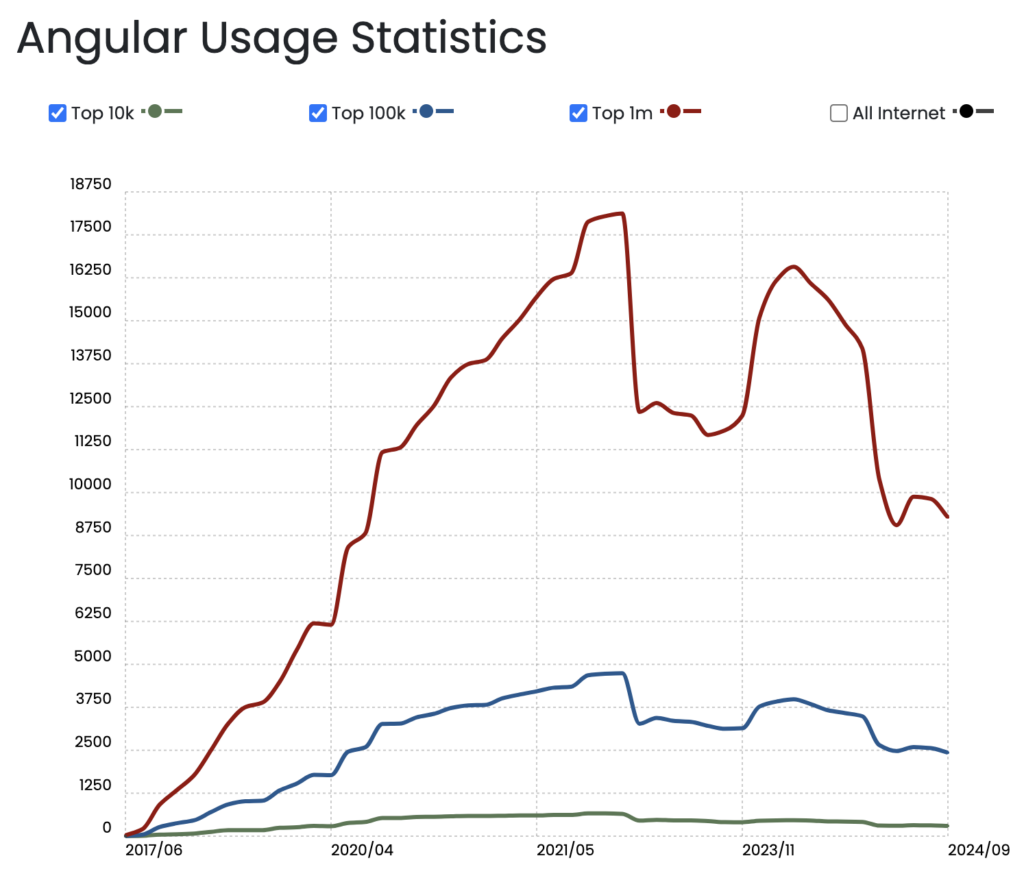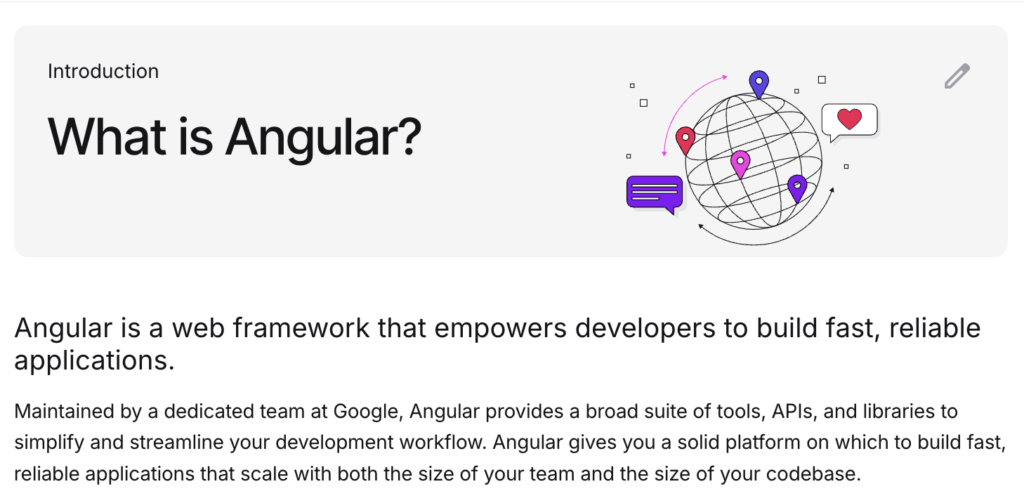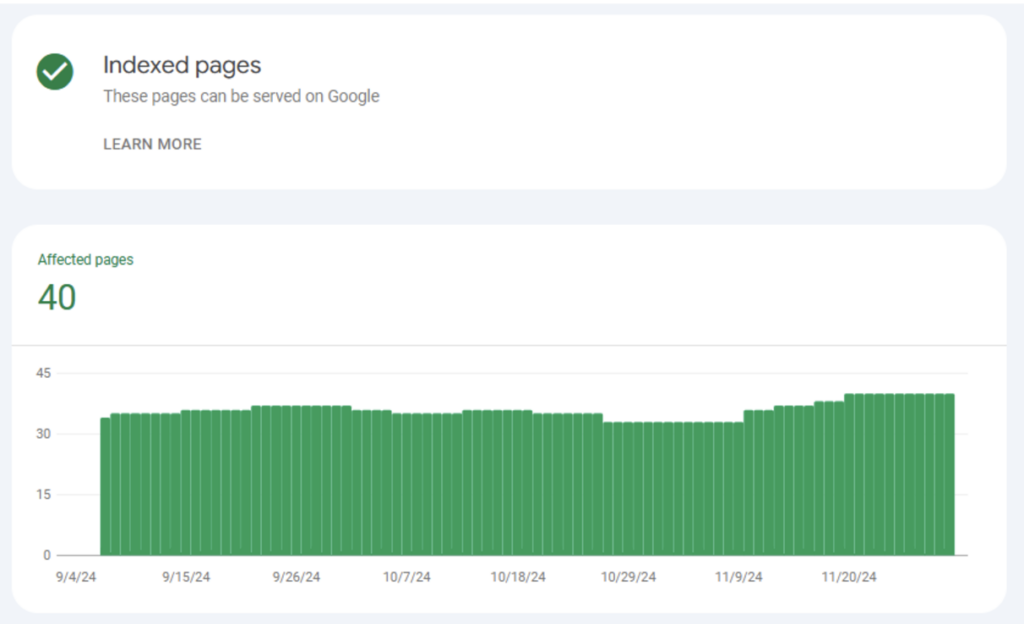Is Angular good for large applications?
- September 06
- 13 min

When building web applications, the tools you pick can feel like choosing the foundation for a skyscraper—get it wrong, and everything on top might crumble. Angular often stands out among the many frameworks available, whether you’re working on a small project or an enterprise-level system. But why has Angular become such a favorite for developers and organizations? And just as importantly, what challenges might you face if you decide to use it?
Angular’s impact on the web development ecosystem is undeniable. According to recent data, approximately 579,160 live websites currently utilize Angular, with an additional 348,061 sites using it historically (BuiltWith Trends). The framework also enjoys a strong foothold in the United States, where about 381,905 websites are powered by Angular.

Here at Hicron Software, we’ve seen firsthand what Angular can achieve. We’ve worked on projects where Angular’s strengths have been game-changers, and we’ve vigilantly addressed the trickier aspects of this robust development framework. Whether you’re curious about its performance, pros and cons, or simply want to know if it’s worth the learning curve, this guide will walk you through everything you need. Let’s dive in!
Angular is more than just a tool for developers; it’s a powerhouse for creating dynamic and scalable web applications. Initially launched in 2010 as AngularJS, it introduced groundbreaking features like two-way data binding and dependency injection. Developers loved the flexibility it provided for front-end development, but as the web grew increasingly complex, AngularJS started to show its age. Fast-forward to 2016, when Google came with an entirely overhauled Angular 2, totally rewritten to stand up to modern software development needs. From that moment, Angular gained complete completeness as a TypeScript-based framework by joining modular design, powerful tools, and a robust community support system.

At its heart, Angular is a component-based framework. That means every piece of an application, from a simple button to an entire dashboard, is built as an independent module. This modularity isn’t just developer-friendly—it’s a lifesaver when your project starts to scale.
Beyond components, Angular has features that simplify complex tasks, like managing application state, handling data flow, and even improving SEO with Angular Universal. Its reliance on TypeScript adds another layer of reliability by catching bugs during development instead of at runtime.
|
Pros of Angular Framework |
Cons of Angular Framework |
|
Comprehensive Ecosystem: Angular offers an all-in-one solution for front-end development, including routing, testing, server-side rendering, and building PWAs. This reduces compatibility issues and streamlines development, especially for large teams. |
Steep Learning Curve: Angular’s extensive feature set and reliance on TypeScript can overwhelm new developers, slowing onboarding and increasing initial development costs. |
|
Modular Development: Its component-based architecture allows developers to break applications into smaller, manageable pieces, making maintenance and scaling easier. |
Verbose Code: Compared to frameworks like React, Angular requires more boilerplate code, which can feel cumbersome for smaller projects. |
|
Seamless Two-way Data Binding: Synchronizes UI and application data in real-time, eliminating the need for manual DOM manipulation and reducing bugs. |
Frequent Version Updates: Regular updates keep Angular cutting-edge but can create headaches when migrating between versions, often requiring refactoring. |
|
TypeScript Integration: Static typing helps catch errors early and improves code quality, making refactoring safer and more predictable. |
Performance Overhead: Angular’s rich feature set can introduce unnecessary overhead for small applications, leading to slower load times without optimization. |
|
Dependency Injection: Built-in DI ensures components remain loosely coupled, making code easier to test and maintain. |
Complex Debugging: Angular’s layered architecture and use of RxJS can make debugging difficult for those unfamiliar with reactive programming. |
|
Angular CLI: Simplifies routine tasks like creating components and optimizing builds, boosting productivity and minimizing repetitive work. |
Dependency on TypeScript: While improving code quality, TypeScript can challenge developers accustomed to plain JavaScript. |
|
Cross-platform Compatibility: Supports server-side rendering (Angular Universal) and PWAs, ensuring applications perform well across devices. |
Not Ideal for Simple Apps: Angular’s setup and structure can feel overkill for straightforward applications. |
|
Scalability for Enterprise-grade Applications: Designed with scalability in mind, Angular excels in handling large-scale, complex projects. |
Customization Complexity: Angular’s opinionated architecture offers limited flexibility for bespoke solutions. |
|
Regular Updates and Support: Backed by Google and supported by a vibrant development community, with regular updates and extensive resources. |
Steeper Development Time for Beginners: Angular’s complexity can increase development time for teams new to the framework. |
|
Built-in Testing Tools: Includes Jasmine and Protractor for writing and running tests, ensuring reliability before launch. |
Compatibility Challenges: Using third-party libraries not explicitly built for Angular can lead to integration and testing difficulties. |
Not every project needs Angular, but when it does, it fits perfectly. It’s like having a Swiss Army knife for web development—packed with tools that make the most sense when the task requires precision, complexity, or both. Angular isn’t just a framework; it’s a complete ecosystem, which means it’s not a one-size-fits-all solution. Here’s when Angular proves its worth.
Take a look at this detailed article: Is Angular Good for Large Applications?
It breaks everything down clearly and practically—definitely worth a read!
If your project has ambitions that are more significant than a simple landing page, Angular is a top contender. It thrives in large, complex environments, where its structured approach can prevent your app from turning into spaghetti code. Features like lazy loading ensure that even the most data-heavy apps load quickly, which is crucial for enterprise-grade tools. Think corporate dashboards, internal systems, or even massive e-commerce platforms with endless layers of functionality. These are Angular’s natural habitat.
From a practical standpoint, Angular’s two-way data binding is tailored for real-time applications. For live chat systems, collaborative environments, or even financial dashboard apps that need updates on the go, Angular keeps data at your app’s backend nicely updated to your user’s view. There is no need for an active refresh and manual synchronization, as anything is live.
Want to build an app that seamlessly runs on both mobile and desktop? Angular’s got your back. With server-side rendering through Angular Universal and Progressive Web Apps support, you can create responsive, cross-platform applications without sweat. Whether on a smartphone or a desktop browser, users will enjoy the same seamless experience.
Some projects are a one-and-done deal, but others live on for years. For long-term endeavors where you’ll be revisiting, updating, and expanding your app regularly, Angular’s structured, TypeScript-powered approach is invaluable. It keeps your codebase maintainable and future-proof, making it easier for new developers to pick up where others left off.
For web applications relying on search engine traffic, Angular offers an advantage in the form of Angular Universal. Enabling server-side rendering, it ensures that your content is crawlable by search engines and enhances your app’s page load times. If your project involves heavy content, be it blogs, e-commerce platforms, or anything with a strong focus on organic search, Angular’s SEO capabilities will be hard to beat.

If you’ve read about web frameworks, you’ve likely seen a million comparisons that pit Angular against React and Vue. Spoiler alert: there is no clear-cut winner. Each framework is suited for different use cases and shines in various ways. Here’s a comparison to help you decide.
What’s interesting is that, according to the 2023 Stack Overflow Developer Survey, 17.46% of developers reported using Angular, positioning it behind React (40.58%) but ahead of Vue.js (16.38%) (GIST). Despite being less commonly used than React, Angular’s comprehensive features and structured approach make it the leading framework in specific scenarios. Additionally, Angular boasts an impressive 55.92% market share in the frontend framework category, solidifying its position as a leader in the field (6Sense).
Angular is an all-inclusive vacation package; everything is included, but it’s up to you to figure out how to use it. With built-in tools for routing, form handling, dependency injection, and many more, Angular is perfect for large, complex applications in which scalability and structure are not to be compromised. On the other hand, this completeness may overwhelm smaller projects or developers who want to avoid committing to learning a heavy framework.
Best for: Big enterprise-level applications, multi-layer complex apps, and teams more comfortable with TypeScript.
React does things very differently. It is not a framework, but just a JavaScript library solely focused on building user interfaces. It is highly flexible, however also means relying on third-party libraries to provide additional functionality for things like state management or routing. React might be good because of its simplicity and the small effort required to build interactive UIs.
Best for: Smaller or medium-sized applications that focus on interactivity or teams that want a lower learning curve.
Vue is a happy medium between Angular’s structure and React’s flexibility. It’s lightweight, beginner-friendly, and integrates easily into existing projects. While it doesn’t come with as many built-in features as Angular, it’s highly customizable and often faster to get up and running.
Best for: Startups, small to medium-sized projects, or teams looking for a simple but powerful framework.
Here’s the deal: If you’re building something massive, complex, and likely to evolve, Angular is your best bet. If you’re after speed and simplicity, react or Vue might be your style. It’s not about which framework is “better”— but what makes the most sense for your project and team.
If you’re deciding between Angular, React, and Vue for your next project, stay tuned! A dedicated article comparing these three popular frameworks is coming soon. Keep an eye out for “Angular vs. React vs. Vue” for all the insights you need!
Choosing a development framework is about choosing the foundation of a house, a decision you would rather not rush. Angular is a powerful and feature-rich option that excels in building scalable, complex web applications. Its TypeScript integration, component-based architecture, and extensive ecosystem make it a reliable choice for projects that require long-term maintainability and enterprise-grade functionality.
But Angular is not without its weaknesses. Its learning curve tends to be steep, and it can seem overkill for minor projects. That is why weighing up the pros and cons of such a framework, as always, needs consideration against available alternatives, React and Vue being some of them. The ideal choice depends upon the goals of your projects, their complexity, and the prowess of your development team.
At Hicron Software, we have worked with Angular on projects of all shapes and sizes. Whether you are considering Angular for the first time or need experts to help you make the most of it, we’re here to help. Let’s talk about how we can bring your vision to life.
